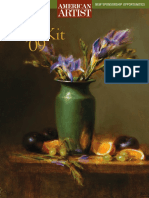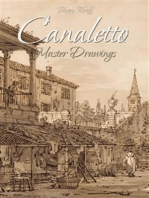RWolf FineArtConnoisseur
RWolf FineArtConnoisseur
Uploaded by
aldosciCopyright:
Available Formats
RWolf FineArtConnoisseur
RWolf FineArtConnoisseur
Uploaded by
aldosciOriginal Description:
Original Title
Copyright
Available Formats
Share this document
Did you find this document useful?
Is this content inappropriate?
Copyright:
Available Formats
RWolf FineArtConnoisseur
RWolf FineArtConnoisseur
Uploaded by
aldosciCopyright:
Available Formats
DETAIL OF CAROLINA, 2006, OIL ON CANVAS, 22 X 20 IN.
THIS IS A REPRINT OF THE ARTICLE THAT APPEARED IN THE SEPTEMBER/OCTOBER 2006 ISSUE OF FINE ART CONNOISSEUR (P. 64-69).
DRAWING (YOUNG WOMAN IN BED) 2004, GRAPHITE ON PAPER, 13 X 23 IN.
64 FINE ART CONNOISSEUR.COM | September/October 2006
NEW YORK
Jacob Collins
A Classical Realist Who Thinks Ahead
By RACHEL WOLF I have been occupied for some time past with a work which is of immeasurable greatness. I cannot tell today whether I shall bring it to a close. It has the appearance of a gigantic dream... Theodor Herzl, 1895
JACOB COLLINS COULD BE SAID TO BE as much of an impossible dreamer as Theodor Herzl (1860-1904) was the year before he published his 1896 treatise outlining his vision to restore a Jewish state in the ancient homeland. Collins desires nothing less than to revive a classical art culture in our time. He is working with artists of every disciplinein his own words, going back to find the larger organizational principles of art. The critic Gregory J. Peterson has described Collins as being at the forefront of the contemporary realism, and many in the art world today agree.1 The respect that Collins has won in his native New York and beyond is demonstrated by the high prices his modestly scaled works command. His 2004 exhibition at Hirschl & Adler Modern on the Upper East Side sold out quickly, and an upcoming show of recent works there (October 5-November 4) has generated an unusual degree of anticipation in his urbane city. Born in 1964 and raised in Manhattan, Collins developed an artistic vision very early. As a child he sketched pictures by such Old Masters as Vermeer, Velazquez, and Rembrandt in the Metropolitan Museum of Art under the watchful eye of his grandmother, Alma Binion Cahn Schapiro, who trained as an artist in Paris. His love for, and skill in, classicism was nourished by his family (his great-uncle was the renowned art historian and critic Meyer Schapiro), yet his set of concerns did not seem to have much currency in Collinss own generation. Undaunted, he pursued his passion, attending the New York Studio School and Columbia College in New York. In 1987, he enrolled in the New York Academy of Art to learn Old Master techniques, then moved to LEcole Albert Defois in France. Collinss first solo show took place in 1990 at the Union League in New York and since then he has presented approximately 20 solo shows and numerous group exhibitions at galleries in the
September/October 2006 | FINE ART CONNOISSEUR.COM 65
YOUNG WOMAN IN BED 2004, OIL ON CANVAS, 28 X 48 IN.
DRAWING (CAROLINA) 2005, GRAPHITE AND WHITE CHALK ON PAPER 16 X 12 IN.
LISE 2006, OIL ON CANVAS, 36 X 46 IN. PHOTOGRAPHED IN COLLINSS STUDIO WHILE HE WAS WORKING ON IT
66 FINE ART CONNOISSEUR.COM | September/October 2006
ROSES 2003, OIL ON CANVAS MOUNTED ON PANEL 10 X 12 IN. PRIVATE COLLECTION
ANNA AND ARTURO 2006, OIL ON CANVAS, 42 X 60 IN.
September/October 2006 | FINE ART CONNOISSEUR.COM
67
GUN 2003, OIL ON CANVAS 8 X 14 IN. PRIVATE COLLECTION
U.S., Europe, and Canada. He has been commissioned to paint portraits of such personalities as J. Paul Getty Ir., George H.W. Bush, and Chief Justice Warren Burger, and hi s work is already in the collections of several American museums and institutions. The show opening this October at Hirschl & Adler constitutes a new gauntlet that Collins has thrown down for himself. As a traditional painter, I would always try to paint all the traditional subjects such as portraits, landscapes, and stilllifes, with the occasional interior scene [as seen in the 2004 show]. But after the last show, it seemed that it would be a challenge to do a show that was entirely one genre, and particularly challenging and gratifying to do the hardest onethe figure. So I threw myself into this show. In the past, I had a little feeling that I always had an outletthat is, to work on different things, to break it up. This time I had to really focus in. Collins thought that having a thematic center would carry the show, and would make it more riveting, more deeply involving, and add an intensity to the visitors experience. Ive been thinking in the last couple years, he says, that the classical tradition is all about the figure after al1.
As often happens, Collins did not pursue success, but success found him as he pursued both his personal passion and a passion for a greater cause. That cause right now is to create, working alongside others, an institutional center for this movement that feels very vigorous and rea1. Looking to classical Greek art culture, as well as to other academic periods such as the Renaissance and the 19th century, Collins understands that in the classical way of thinking there is a dynamic interrelationship among the arts. Often the same person was both an architect and a sculptor. During the Renaissance, paintings were not merely independent decorations on walls; they were made to fit into the architecture. In this spirit, Collins has been involved in founding two schoolsthe first formal initiatives toward his vision of a renewed art culture. His Water Street Atelier is no longer on Water Street in Brooklyn, but rather on the Upper East Side, where Collins continues to teach approximately 12 young artists in a studio attached to his home. This mode of instruction derives from the long tradition in which students learned in the studio of a particular painter, where they would fully grasp that painters craft and
STUDY FOR BURMA ROAD, FIRE ISLAND 2003, OIL ON CANVAS MOUNTED ON PANEL 83/4 X 16 IN. PRIVATE COLLECTION
68
FINE ART CONNOISSEUR.COM | September/October 2006
BREAD AND WATER 2003, OIL ON CANVAS, 9 X 13 IN. PRIVATE COLLECTION
Looking to the Future
The Institute of Classical Architecture & Classical America (ICA&CA) has just launched The Grand Central Academy of Art, a program of progressive instruction in painting and drawing conceived by exhibiting artists to enliven the institutes mission of advancing the classical tradition in architecture, urbanism, and the allied arts. Academy students work in a 2,700-squarefoot suite of studios on the skylit sixth oor of the institutes headquarters in the landmark General Society of Mechanics and Tradesmen building (20 West 44th Street in midtown Manhattan). Faculty member Michael Grimaldi says that the curriculum centers on the three-year, full-time Intensive Program, in which students gain an objective understanding of visual phenomena and the classical principles of form, design, and practice. Evening and weekend classes are offered for artists of varying skill, as are public symposia and lectures on the humanistic impulses that have always enlivened classicism. ICA&CA President Paul Gunther notes, In the middle of the 20th century, the classical tradition in art was at a low ebb. Today, interest in realist art among students and in the marketplace is resurgent across a broad spectrum of media and thematic content. Academy co-founder Jacob Collins observes that There are many practitioners today across the country and in Europe who have been attempting this revival of classical training. Yet the major American institutions of art have not participated in this change. There are also growing numbers of commercial art galleries devoted to the careers of classical realists. ICA&CA Education Director Victor Deupi adds that The board, staff, and growing national constituency of the institute gratefully acknowledge the Morris and Alma Schapiro Fund for making possible this auspicious new cornerstone of the institutes academic program. In addition, ICA&CA recently announced the establishment of the Alma Schapiro Prize, a fellowship at the American Academy in Rome (AAR) for a distinguished American student or professional with demonstrable commitment to the classical tradition and its contemporary practice in painting and sculpture. Starting in autumn 2007, it will be offered in years alternating with the institutes RiegerGraham Prize, which sent its rst architect fellow, Tiffany Abernathy, to the AAR this September. Applications must be received by November 15, 2006. The endowment supporting the prize is made possible by a grant from the Morris and Alma Schapiro Fund. Fund President Linda S. Collins observes that Alma Schapiro would be happy this prize has been instituted in part because she herself was sent to Paris, instead of college, by her art-loving mother to study at the Acadmie de la Grande Chaumire and the Acadmie Julian when she was scarcely 20 years old. She worked in Paris for a year and a half and made a trip to Belle le and another to Italy. She often spoke of her rst glimpses of Michelangelo, Fra Angelico, and Piero della Francesca.
September/October 2006 | FINE ART CONNOISSEUR.COM 69
ideas before developing their own. Through Water Street, Collins has taught such talented and productive artists as Juliette Aristides, Nora Daniel, Edward Minoff and Nicholas Raynolds. The latest project, The Grand Central Academy of Art, is a venture that Collins and a group of like-minded fellow artists have started in close cooperation with the Institute of Classical Architecture & Classical America. The academy centers on a rigorous program that starts with students drawing from a superb collection of plaster casts donated to the institute recently by the Metropolitan Museum of Art, then onward to figure drawing and painting, including classes in technical perspective, anatomy, and art history. The academy will offer its first courses in September. New York is already a place of many artists, as well as amateurs, collectors, dealers, and writers who have similar ideals. There only needs to be a nexus for these people to coalesce, says Collins. (See the sidebar for more on the academy.) By contrast, Collins regards the contemporary art world almost as if its practitioners, isolated from each other, are wandering in a sort of cultural diaspora. He feels that the art culture of today has been impoverished by the rejection of an ideal of beauty, an interest in appearances to the exclusion of form, and a pursuit of the mundane. He is, therefore, dedicated to changing the culture of the art world in fundamental and enduring ways. Theodor Herzls impossible dream came to fruition in a mere 50 years. With time and dedication, Jacob Collins may very well achieve his dream. In the meantime, he offers a significant voice, broadening and enriching the art scene in New York and beyond.
RACHEL WOLF is contributing writer for Fine Art Connoisseur. Galleries: Represented exclusively by Hirschl & Adler Modern, New York, with a professional relationship with John Pence Gallery, San Francisco. Website: jacobcollinspaintings.com 1 Gregory J. Peterson at www.artcritical.com/peterson/GPCollins. htm (July 2004).
You might also like
- Ilya Repin - 541 Artworks - PaintingDocument1 pageIlya Repin - 541 Artworks - PaintingJoão Maia FrançaNo ratings yet
- Charlotte - Zorn PaletteDocument8 pagesCharlotte - Zorn PaletteServane Valles100% (2)
- WS01 Two Day Workshop: Cuong Nguyen "The Glowing Portrait" Tue/Wed, June 6, 7Document2 pagesWS01 Two Day Workshop: Cuong Nguyen "The Glowing Portrait" Tue/Wed, June 6, 7nikhilDNo ratings yet
- Angel Academy Process by Alison de SandoDocument4 pagesAngel Academy Process by Alison de SandoAlison De Sando ManzoniNo ratings yet
- Malcolm T LiepkeDocument2 pagesMalcolm T Liepkemoz1979No ratings yet
- Children's Portraits of John Everett MillaisDocument45 pagesChildren's Portraits of John Everett MillaisD. Rafaela da Silva Melo100% (1)
- Drawing Today: Classical Academies How To Win A GrantDocument11 pagesDrawing Today: Classical Academies How To Win A GrantKingkin Galih La Rose100% (3)
- Va - Family Tree Watercolor RubricDocument1 pageVa - Family Tree Watercolor Rubricapi-240690135No ratings yet
- Pintando El Retrato - de LászlóDocument95 pagesPintando El Retrato - de LászlóGandhi Palomino0% (1)
- The Last History Painter - William Adolphe Bouguereau - The Imaginative ConservativeDocument4 pagesThe Last History Painter - William Adolphe Bouguereau - The Imaginative ConservativeNadge Frank AugustinNo ratings yet
- Tradition in The 21 Century Daniel GravesDocument23 pagesTradition in The 21 Century Daniel Graves2bac_bhNo ratings yet
- Hills Catalogue PreviewDocument24 pagesHills Catalogue Previewtakat05100% (3)
- American Art Collector - December 2019Document182 pagesAmerican Art Collector - December 2019PSM171100% (1)
- Lein IRE IN Aine: July 24, 2013 John Singer Sargent's Painting Methods and PaletteDocument8 pagesLein IRE IN Aine: July 24, 2013 John Singer Sargent's Painting Methods and PaletteBorch100% (1)
- Artofportraitpai00coll PDFDocument234 pagesArtofportraitpai00coll PDFAlison De Sando Manzoni100% (2)
- Monet's Methods: Rouen Cathedral at Sunset, 1893, Musée Marmottan Monet. An Example of TheDocument2 pagesMonet's Methods: Rouen Cathedral at Sunset, 1893, Musée Marmottan Monet. An Example of TheBrinzei LucianNo ratings yet
- Anders Leonard Zorn Stealing Secrets and Beauty by Elaine Adams2Document9 pagesAnders Leonard Zorn Stealing Secrets and Beauty by Elaine Adams2Victor Figueroa PeñaNo ratings yet
- Everything We See Is PuzzlingDocument8 pagesEverything We See Is PuzzlingHove ResidentNo ratings yet
- Encajar Vrs Sight SizeDocument3 pagesEncajar Vrs Sight SizeAnonymous Y2qwEuANo ratings yet
- Vasily Surikov, Russian History PainterDocument3 pagesVasily Surikov, Russian History PainterAlly DeanNo ratings yet
- Portrait of AnnaDocument55 pagesPortrait of AnnaDan RankinNo ratings yet
- American Artist Media Kit 2009Document9 pagesAmerican Artist Media Kit 2009Interweave33% (3)
- Portrait and Figure Painting PDFDocument94 pagesPortrait and Figure Painting PDFAnkitaBansalGarg100% (4)
- Impressionist Metropolitan PDFDocument256 pagesImpressionist Metropolitan PDFSofija Grubač100% (2)
- Alex Kanevsky: Notes From The Espaint Madrid Workshop June 2015Document4 pagesAlex Kanevsky: Notes From The Espaint Madrid Workshop June 2015William TheodoracopulosNo ratings yet
- Colour Mixing: Exploring The Zorn Palette - JacksDocument3 pagesColour Mixing: Exploring The Zorn Palette - Jackscaca de vacaa0% (1)
- Drawing Nature and DifferentsDocument67 pagesDrawing Nature and DifferentsAntonio UngureanNo ratings yet
- The Finest Quality Handmade Artists' Brushes: Autumn/Winter 2015Document64 pagesThe Finest Quality Handmade Artists' Brushes: Autumn/Winter 2015williampsilva315100% (1)
- Cesar Santos' Experience at The Angel AcademyDocument73 pagesCesar Santos' Experience at The Angel AcademyAlison De Sando ManzoniNo ratings yet
- Angel Painting MethodDocument5 pagesAngel Painting Methodsmbody11No ratings yet
- Artist's Back To Basic - Issue 5 No.3 2015Document84 pagesArtist's Back To Basic - Issue 5 No.3 2015sajsajNo ratings yet
- Jeffrey Watts American ArtistDocument8 pagesJeffrey Watts American ArtistSally Puddle67% (3)
- Flemish Drawings FINALDocument26 pagesFlemish Drawings FINALShaun Day100% (1)
- The Pain of Others - DraftDocument107 pagesThe Pain of Others - Draftdinko19100% (2)
- Quebec's Robert Roy Paints Passion in Every StrokeDocument35 pagesQuebec's Robert Roy Paints Passion in Every Strokesumendersingh100% (1)
- What Are WatercoloursDocument5 pagesWhat Are Watercoloursjeremy parkerNo ratings yet
- John Singer Sargent's Painting TechniquesDocument16 pagesJohn Singer Sargent's Painting Techniquesbhuban02038350% (2)
- Plein Air Past: From Europe To AmericaDocument2 pagesPlein Air Past: From Europe To AmericaInterweaveNo ratings yet
- Realistic Portrait Painting Techniques, Processes and Expert Opinion PDFDocument13 pagesRealistic Portrait Painting Techniques, Processes and Expert Opinion PDFBorchNo ratings yet
- Artists & Illustrators - October 2023Document84 pagesArtists & Illustrators - October 2023Judah Ramos100% (2)
- Canadian Scapes: The Big The Big Picture' Picture'Document20 pagesCanadian Scapes: The Big The Big Picture' Picture'sumendersingh100% (1)
- PDFDocument290 pagesPDFLoredana Cenusa100% (3)
- Old Master Drawing and Painting John Singer SargentDocument16 pagesOld Master Drawing and Painting John Singer SargentVeronica Mtz100% (1)
- Antonov-Portrait of Anna - FullDocument213 pagesAntonov-Portrait of Anna - Fullapocacosta100% (1)
- Ship High Seas WorkbookDocument5 pagesShip High Seas WorkbookServane VallesNo ratings yet
- Flemish Oil Painting With Sadie J. Valeri - Closed Grisaille - by Julia Lundman - MediumDocument1 pageFlemish Oil Painting With Sadie J. Valeri - Closed Grisaille - by Julia Lundman - MediumMohamed Abou El hassanNo ratings yet
- Dean Cornwell NotesDocument3 pagesDean Cornwell NotesdmalcaruizNo ratings yet
- Winter Plein Air Issue: A Visit To The Arts & Letters Club of Toronto Crayons Started Art CareerDocument25 pagesWinter Plein Air Issue: A Visit To The Arts & Letters Club of Toronto Crayons Started Art Careersumendersingh100% (2)
- Jeremy Lipking American Artist Workshop Fall 2007Document18 pagesJeremy Lipking American Artist Workshop Fall 2007coinop100% (1)
- Paint Draw - Watercolour Landscapes 2nd Edition 2023Document132 pagesPaint Draw - Watercolour Landscapes 2nd Edition 2023Emanuel SilvaNo ratings yet
- Athematical Onographs: Intrinsic Geometry of SurfacesDocument6 pagesAthematical Onographs: Intrinsic Geometry of SurfacesaldosciNo ratings yet
- Oil Painting TechniquesDocument23 pagesOil Painting Techniquescarloslopez85No ratings yet
- An Introduction To Oil Painting PDFDocument74 pagesAn Introduction To Oil Painting PDFMarius Mocanu100% (5)
- Sharipov Analitic GeometryDocument227 pagesSharipov Analitic Geometryaldosci100% (1)
- Final ReportDocument21 pagesFinal ReportMaria Gracia ArquilloNo ratings yet
- Kamapehmilya: Elements and Principles of ArtsDocument8 pagesKamapehmilya: Elements and Principles of ArtsderNo ratings yet
- 21st Century LearnerDocument10 pages21st Century Learnerjm lucesNo ratings yet
- Piet ZwartDocument3 pagesPiet ZwartRaji PunjabiNo ratings yet
- Performing Arts, Graphic and Plastic ArtsDocument14 pagesPerforming Arts, Graphic and Plastic ArtsTrixie Mae QuinitaNo ratings yet
- Pepper Creative BrochureDocument17 pagesPepper Creative BrochureDinesh CNo ratings yet
- 495 Etsy Facebook GroupDocument56 pages495 Etsy Facebook GroupKhairul SabirinNo ratings yet
- Literary Realism in Nineteenth Century FranceDocument5 pagesLiterary Realism in Nineteenth Century Francerupal aroraNo ratings yet
- Art Appreciation Prelim 30 30 PDFDocument3 pagesArt Appreciation Prelim 30 30 PDFJayson LucenaNo ratings yet
- What Is LiteratureDocument2 pagesWhat Is LiteratureGeean100% (1)
- Information Age Gutenberg To Social-MediaDocument17 pagesInformation Age Gutenberg To Social-MediaAlliyah CristyNo ratings yet
- 1 Ene. PomeloDocument3 pages1 Ene. PomeloMaria Margarita Castells100% (3)
- L4 Art Criticism and Aesthetic JudgmentDocument25 pagesL4 Art Criticism and Aesthetic JudgmentGileah Ymalay ZuasolaNo ratings yet
- Chapter 4 Elements of MusicDocument43 pagesChapter 4 Elements of MusicRaze AlemaniaNo ratings yet
- Claude-Nicolas LedouxDocument5 pagesClaude-Nicolas LedouxKeanu KuanNo ratings yet
- Wisdom Conquers IgnoranceDocument5 pagesWisdom Conquers Ignoranceyahya333No ratings yet
- Musical Analysis and Journal Entry For Week 5Document4 pagesMusical Analysis and Journal Entry For Week 5blon majorsNo ratings yet
- Sacristy TreasuresDocument3 pagesSacristy TreasuresDouglas LeBlancNo ratings yet
- Arts 07 Curriculum MapDocument13 pagesArts 07 Curriculum MapJosefino HapitanNo ratings yet
- Formalism Refer WPS OfficeDocument2 pagesFormalism Refer WPS OfficeJerel John CalanaoNo ratings yet
- ZALAKDocument1 pageZALAKriyqNo ratings yet
- Hoja de Especificaciones de LedDocument6 pagesHoja de Especificaciones de LedJorge Omar Sanchez VenegasNo ratings yet
- P Art SyllabusDocument2 pagesP Art Syllabusapi-223541325No ratings yet
- Chapter 2 Languge of Visual ArtsDocument16 pagesChapter 2 Languge of Visual ArtscindyNo ratings yet
- Water Painting TechniquesDocument17 pagesWater Painting Techniquesmamasava100% (1)
- Rosalind Krauss Is A Highly Influential Art Critic and Theorist Whose Career Was Launched in TheDocument2 pagesRosalind Krauss Is A Highly Influential Art Critic and Theorist Whose Career Was Launched in TheJuvylene AndalNo ratings yet
- When Fashion Meets ArtDocument4 pagesWhen Fashion Meets ArtAlma PérezNo ratings yet
- Free Cloud Computing PPT Templates: Insert The Subtitle of Your PresentationDocument48 pagesFree Cloud Computing PPT Templates: Insert The Subtitle of Your PresentationAndira dwiNo ratings yet
- Cpar 12Document156 pagesCpar 12AVILA Princess C.No ratings yet





























































































